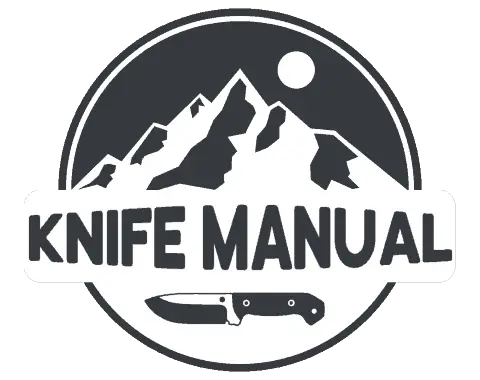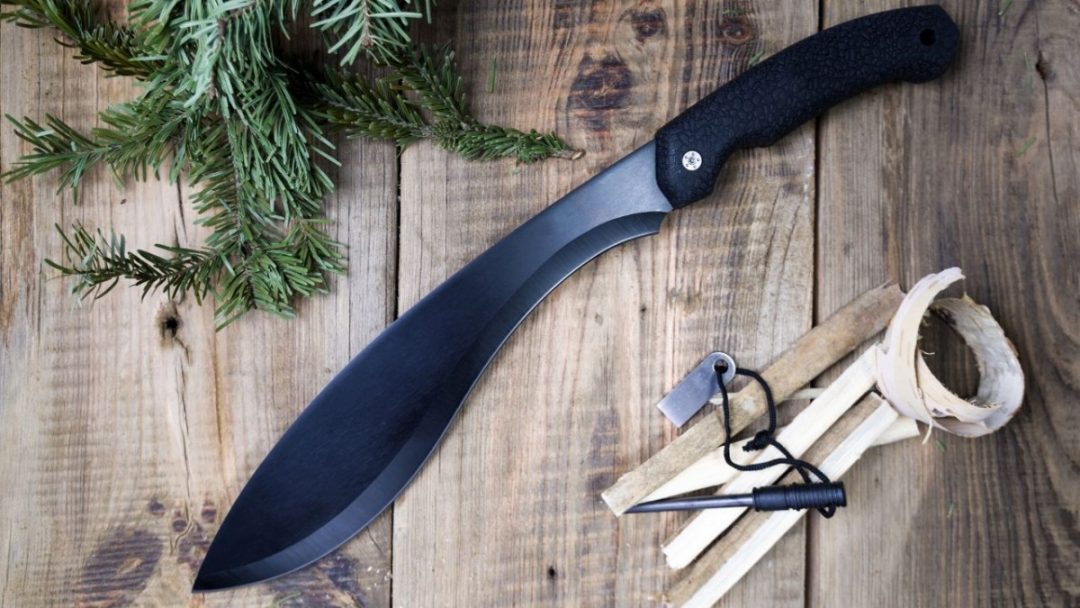
Many people don’t think of a kukri when they imagine a survival knife, but is this because they don’t work well for this purpose or is it because they are just not very common? I did some research to find out the answer, and this is what I found.
A kukri knife can make a good survival knife if the user has the skill and experience to use it properly. It might take some time to get used to the unique shape and design of a kukri blade, but once comfortable, kukri knives are very versatile and helpful tools, especially in survival situations.
While they are very different from your standard survival knife or Bowie knife, kukri knives are a very underutilized style of knife in the survival world. It really surprises me that not many people use kukris for survival because they are very versatile tools that can handle many tasks with ease that other survival knives would struggle to handle. There are, however, some downsides that you have to consider as well.
Table of Contents
Are Kukri Knives Good Survival Knives?
The question of whether or not a kukri makes a good survival knife is sometimes debated because it is a very unique blade that is far different from an average survival or Bowie knife. There are definitely aspects of a kukri knife that lend themselves to survival, and there are aspects of it that could hinder the user in a survival situation.
This question of whether or not a kukri is a good survival knife has no clear answer. Whether it is a good blade for survival really only depends on the user and their skills and abilities with using a kukri. Kukri blades are designed so differently from an average survival knife that it often takes a lot of practice and skill to be able to use on properly.
For many people, using a kukri as a survival knife would be a bad idea because of the steep learning curve that it has. But as soon as you get over that barrier of learning how to effectively use a kukri, it suddenly becomes a very useful and versatile blade because you are able to wield it properly.
There are just so many unique factors and characteristics of a kukri knife that it is impossible to say whether or not it is a good survival knife for everyone. In my opinion, kukri knives make amazing survival knives but that is not the case for every person out there.
To really tell whether or not a kukri will be a good survival knife, you have to look at what it offers and what the drawbacks are and make an informed decision.
What Makes a Kukri Knife Good for Survival
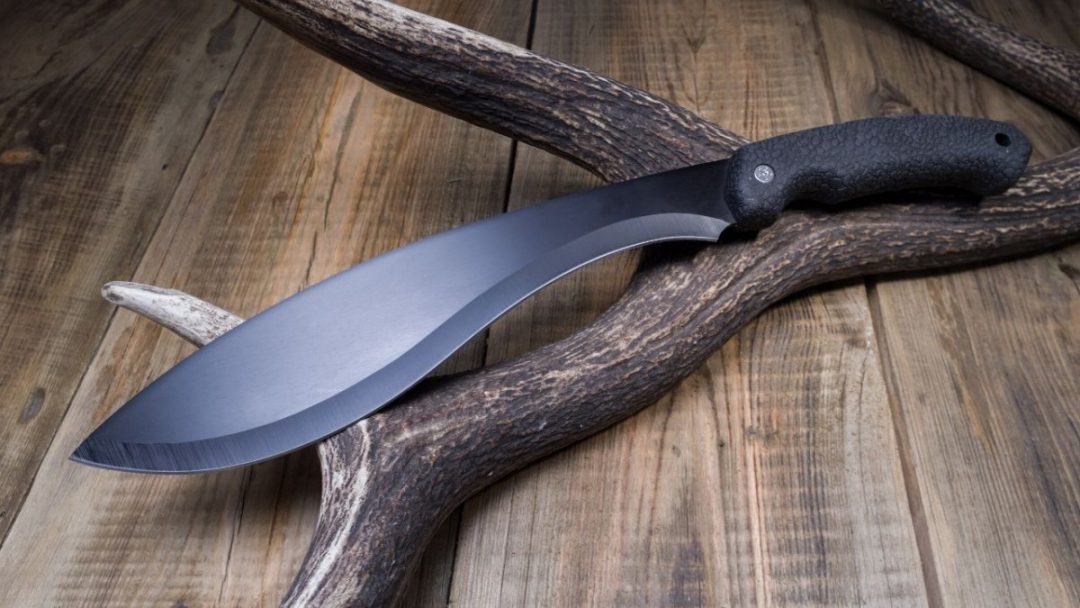
As I have previously mentioned, kukri knives have many redeeming and great qualities that make them excellent survival knives for many people. But it is really up to you to decide whether it would make sense for you to use one as your survival knife.
In general, a survival knife is almost useless if the user doesn’t know how to properly and effectively use it. Just think about it, if someone had never used a survival knife before and they were handed a blade, the outcome would be bad because the user has no idea how to use the knife. The same thing applies to kukri knives; if the user doesn’t know how to use it, it becomes more of a burden and they should have chosen a blade that they knew how to use effectively.
With all of that said, there are many great things about a kukri knife that makes it ideal for survival and outdoor use.
Size
One really great aspect of a kukri knife is the size of the blade and the overall tool. This really lends itself well to survival activities because many of them are quite intensive and a larger blade can help to complete some tasks easier and faster.
While a smaller and more traditional survival knife often hinders you from working with larger materials because of its blade size, kukris are big enough so this problem is avoided. With relative ease, you can use a kukri knife to chop and work with large pieces of material because the blade is big enough to handle them.
Strength
Another great aspect of a kukri knife is the fact that they are often made to be super strong and durable. Don’t get me wrong, there are kukri knives out there that are weak and will not hold up through intensive use, but many are quite strong and durable.
This type of strength in a kukri allows you to process and tackle large and intensive tasks without the fear of your blade breaking or failing in any way. This is a really important quality to have in any survival knife because the last thing you ever want to happen is for the tool that is enabling you to survive to break. That would just suck and make your chances of survival decrease dramatically.
Versatility
With all of these great attributes on its side, kukri knives become very versatile and there aren’t many jobs that one can not tackle for lack of strength or size. It just opens up many doorways to many diverse jobs and tasks that you can accomplish with a kukri.
Having a versatile survival knife is actually very crucial in a survival situation. Survival brings many unknowns and surprises and having a knife that can handle all of them takes a little bit of stress and allows you to focus on staying alive. The versatility and strength of a kukri knife just make them perfect for survival because those are the exact attributes that a good survival knife has and many traditional knives lack.
What Makes a Kukri Knife Bad for Survival
While kukri knives might seem like the perfect survival knives because of their size, strength, and versatility, there are aspects of them that are not so good for survival and might hinder someone in a survival situation.
None of these are completely detrimental to a kukri being used as a survival knife, they are just small qualities that could hinder someone. In reality, any blade is better than no blade in a survival situation. I’m sure that you would be able to figure out how to overcome these problems if you were faced with a survival situation. They just make a kukri not the idea survival knife and can be something to consider when thinking about whether or bot a kukri would make a good survival knife for you.
Curved Blade
While this might not always be a downside to a kukri, the curve in the blade can sometimes hinder the use of the tool or create problems that normal survival knives would not encounter. Really, its just a very different blade design from what common knives have, so it will come with its benefits and drawbacks.
Especially in survival situations, the curve in the blade might be more of a problem than you might realize. Suddenly, the simple task of processing food or carving wood that can be done quite easily with a traditional knife is harder because the blade of a kukri is curved.
Some kukri blades are curved more than others, but the more traditional styles have quite the bend in the blade. Newer models and designs of the classic kukri sometimes look more like a machete and the potential problems that a curved blade brings are eliminated in the newer kukris.
Some people find it a hindrance and some like the curve in the blade, either way, it is quite a different design from a standard survival knife and could potentially cause problems and frustration when you are doing some tasks.
Small Handle
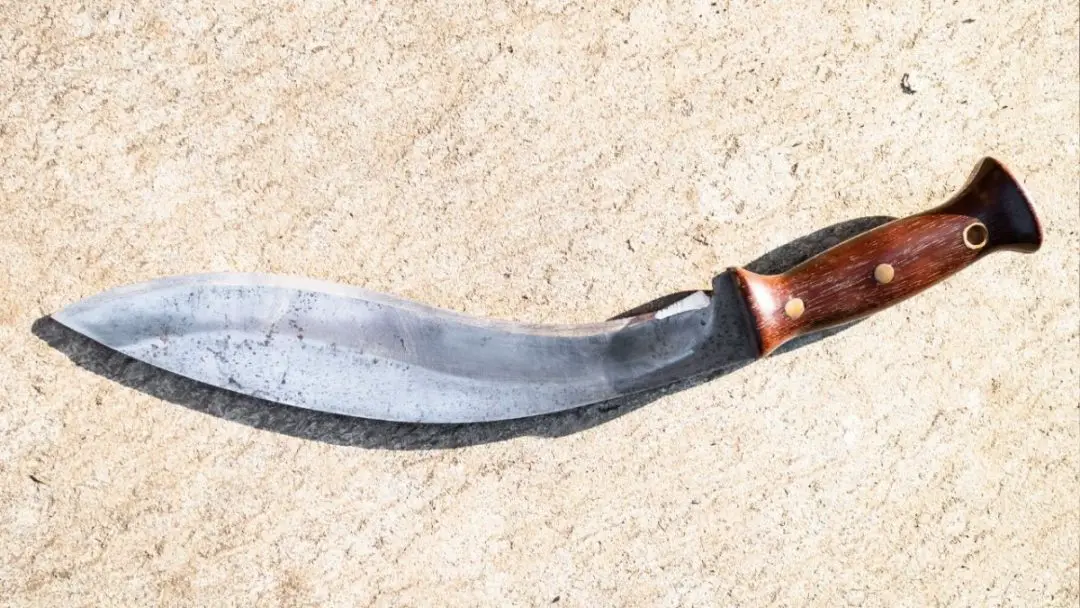
This is more of a potential problem with more traditionally designed kukris, but the handle of these tools is often quite small. While they are far from being too small to be held and useful, they are often on the smaller side of things and this could cause problems if you use a kukri for a survival knife.
In survival situations, and really whenever you use your blade, you need to keep a firm and steady grip on your tool. This is crucial for keeping in control of your knife and effectively using it to complete whatever task you are performing. If your handle is too short, it could cause you to lose grip of your knife and hurt yourself, others, or what you were working on.
For most tasks, the handle on a kukri will be small but not so small that it will cause an issue or discomfort. But in a survival situation, you really need to have a strong grip on your kukri and the size of the handle could cause some issues and headaches. This is not a problem with all models, but it is something to think about when you are choosing whether or not to use a kukri as your survival knife.
Learning Curve
This downside to a kukri knife sort of includes all of the previously mentioned drawbacks as well as any that I didn’t mention in this article. At its source, the main downside to using a kukri as a survival knife is that it is a vastly different style and design when compared to a standard survival knife.
With practice and experience, this drawback lessens and might even disappear, but for new people using a kukri, it will cause many issues. The design and way you use a kukri, while not too different, is different enough to cause a problem.
This is amplified when you are put into a survival situation where you are unable to focus as much on how you are using your tools because you need to focus on surviving. It’s just a different tool and you need to learn how to properly use it so that you don’t have to think about it and you are able to effectively work with it in a survival situation.
At the end of the day, a kukri knife is just a different style and kind of knife and, just like anything unfamiliar, it takes practice to learn how to use it effectively.
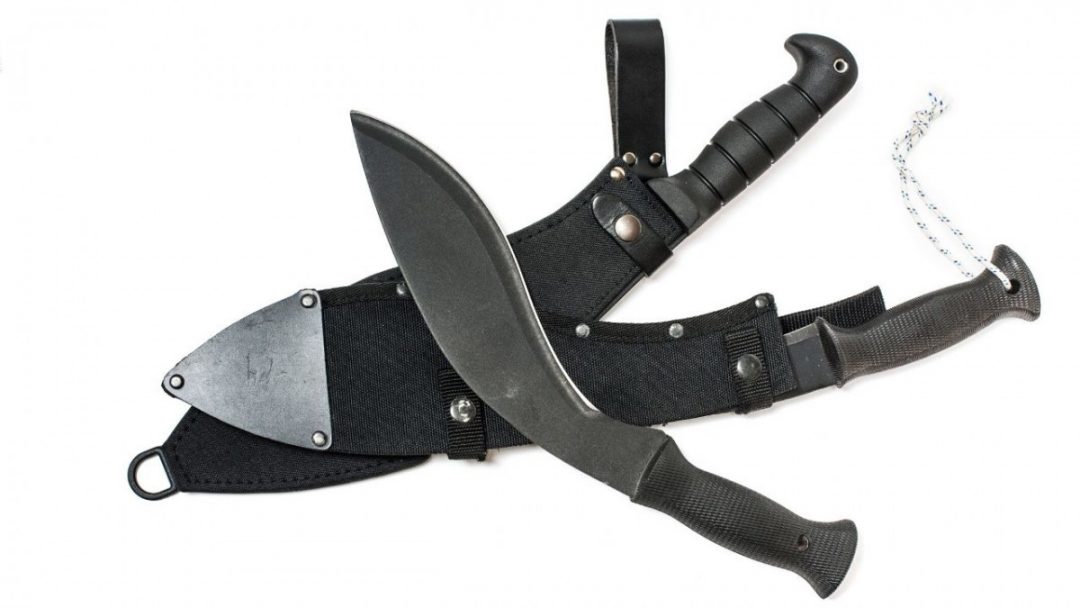
What to Look for in a Kukri Knife that is Intended for Survival
There are many different designs of kukris, and there are some qualities and aspects that you should look for in one if you plan to use it as a survival knife. Obviously, these are not necessary for a kukri to have to be effective in a survival situation, but they would make it a lot easier and would be ideal qualities.
It is completely possible to effectively get tasks done with almost any blade. These qualities are just general things to look for to get the best experience if you are going to use your kukri for survival purposes. But even if your kukri doesn’t have all of these qualities, or it has just a few of them, it can still work great and be a wonderful tool to have when you are in the outdoors.
Design
For a kukri that is intended for survival purposes, I would lean toward one of the newer designs that sort of resemble a small machete. While this might be largely personal preference, it seems like these designs are much more practical and useful for someone that is used to using a normal machete or survival knife.
The design change would just be less drastic than if you chose a very traditional kukri design and it might be easier for someone to effectively use it without a lot of practice or experience. This would just shorten, or completely eliminate, the learning curve that often comes with learning how to use a kukri and their unique design.
Overall, you should find a design that is both useful and that you are comfortable using. It would be pointless to find a kukri that has a cool design but is either uncomfortable to use or you just hate using it. That would just cause more problems than it solves, and the whole reason that you would carry a knife in the first place would be to solve problems and complete tasks.
The balance and proportions of the kukri are important as well. While all kukri designs seem to have a smaller handle and a pretty large blade, this proportion should be within reason and practical. When you pick up and use the kukri, it should feel balanced and not super heavy on the handle or the blade end.
Blade
The blade of a kukri that is going to be used for survival purposes is extremely important. This is the thing that is going to either keep you alive or fail you, and while a lot of that is up to things out of your control as well as your skill, having a solid and practical blade is always a good idea.
For the blade of a kukri that is intended for survival, it is important to look for practicality over style and beauty. There are many kukri designs and blades out there that are for show and are made to show off the tool’s history or the craftsmen’s skill, but all of that does nothing to keep you alive when you are trying to survive.
When you are actually in a situation where you are depending heavily on your survival knife, you will not be thinking about how well the knifemaker shaped the blade or the rich history behind the design. You will most likely be focused on continuing to breathe.
Just look for a blade that has a very practical design and is made out of durable and strong metal. Make sure that the craftsman or knifemaker that makes your blade is also knowledgeable and does quality work. You will thank yourself later if you spend the time to find a really great kukri blade that is practical, strong, and well made.
Handle
As I previously mentioned when I was going over the potential downsides to using a kukri as a survival knife, the handles on many traditionally designed kukris are often quite small. This becomes less of an issue with newer and more machete-like kukris because the handles are often bigger, but it is something to think about when choosing a kukri for survival.
For a blade to be actually useful and effective in survival and intense situations, it must be comfortable and easy to use. Having a handle that is large enough to hold on to and grip comfortably will increase your ease of use by a lot. It would just be really annoying if your kukri had such a small handle that you spent more energy trying to keep a grip on it and not on the task that you were trying to accomplish.
Besides the actual size of the handle, it should also be made out of a durable and grippy material. There are many synthetic options out there that work wonderfully and are nice and grippy. The main thing that I would personally avoid for a survival kukri handle is natural materials.
In some cases, they might make sense and work, but I just don’t like to take my chances on a tool that could potentially be the thing between be living and dying. Wood and other natural materials that are commonly used as handle materials are just too susceptible to deterioration and are not as durable as a survival tool often requires.
Best Kukri Knives for Survival
There are many kukris out there on the market today, but its sometimes hard to find the ones that work best for survival and intensive outdoor use. Many of the kukri designs and models are made for decoration and to honor the heritage of the tool, and while this is all fine and good, they often won’t work well in a survival situation.
Below are my personal favorite kukri knives for survival. All of the kukris mentioned below would work wonderfully for survival and meet the requirements and criteria for a survival kukri that I laid out previously in this article.
Cold Steel Kukri Plus

A simple and yet elegant kukri design by Cold Steel, the Kukri Plus is a really great tool that can work as a survival knife if the need arises. This kukri is just super well made and has a really clean design that allows you to focus on the task at hand and not get distracted with decoration and features on your tool.
The blade is really sharp, expertly tempered, and stays sharp even after a lot of use. The handle is made of polypropylene and nicely textured so you can keep a good grip on the knife. Overall, the Cold Steel Kukri Plus is a really great kukri for survival and just about anything else you could use a kukri for.
CRKT KUK

The Columbia River Knife and Tool KUK is a really great and durable kukri for survival. The entire tool is made of really great and high-quality materials and is well constructed. While many more traditional kukri designs have a really curved blade, the CRKT KUK has a slightly less curved one that lends itself well to survival activities.
This full tang knife is just super well made and made of durable materials. The handle on the KUK is made of polypropylene and has a good texture to it. The ergonomics of the entire kukri are also great and make it easy to use and hold the tool during intensive use or for a long time. Altogether, the CRKT KUK is a really solid survival kukri option that is well made, durable, and ready for action.
OKC Kukri

Great for survival and outdoor use, the Ontario Knife Company Kukri is a really solid, durable, and reliable blade. OKC is a really great knife maker that I really love and their kukri does not disappoint. The design is well balanced and the entire kukri is perfectly made for survival and intensive use.
The blade of the OKC Kukri is made of the ever-popular 1095 carbon steel and holds an edge even after a lot of use. The handle on this kukri is made of G-10 and is textured by having grooves around the handle to make it more grippy. Overall, the OKC Kukri is a really great survival knife option and checks off all of the boxes for a tool that you can rely on and trust in a survival situation.
Are Kukris Better than Traditional Survival Knives for Survival?
This is not a straightforward answer because they are so different and are great for different tasks and scenarios. Both kukris and traditional survival knives are great for survival, but it is hard to tell for certain which one is better.
Personally, I think that traditional survival knives are just ever so slightly better for survival than kukris because you can do a lot more detailed and delicate work with them. It would just be a real pain to try to make a fire using a primitive bow drill kit using a kukri as your cutting tool. But then again, kukris are able to complete larger and more intensive tasks with relative ease where a traditional survival knife might struggle.
In the end, both kukris and traditional knives have their advantages and drawbacks, and it really depends on your preferences and what tasks you need to complete to decide which one is a better survival knife. Listening to an opinion of why one is better for survival than the other is almost useless because it really comes down to your needs and preferences.
Conclusion
There is a lot to think about regarding kukris as survival knives, but the main takeaway is that kukri knives are great for survival. There are certain things that I would personally look for in a kukri that is intended for survival purposes, but they are not absolutely necessary.
It might take some practice and time to become comfortable using a kukri if you are accustomed to traditional survival knives, but it is well worth the effort because kukris can make really great and helpful tools. Kukri knives are just very unique blades that have a lot of uses and potential but just might take some time to get used to.
